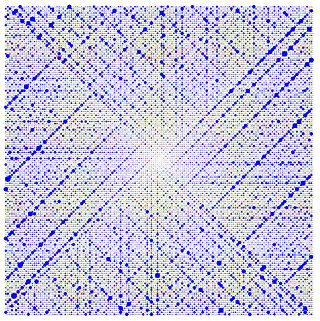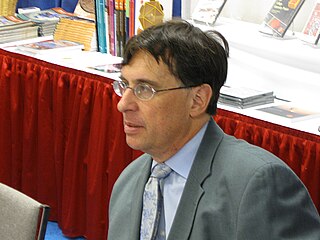Related Research Articles

Algebraic geometry is a branch of mathematics which uses abstract algebraic techniques, mainly from commutative algebra, to solve geometrical problems. Classically, it studies zeros of multivariate polynomials; the modern approach generalizes this in a few different aspects.
Combinatorics is an area of mathematics primarily concerned with counting, both as a means and as an end to obtaining results, and certain properties of finite structures. It is closely related to many other areas of mathematics and has many applications ranging from logic to statistical physics and from evolutionary biology to computer science.

Discrete mathematics is the study of mathematical structures that can be considered "discrete" rather than "continuous". Objects studied in discrete mathematics include integers, graphs, and statements in logic. By contrast, discrete mathematics excludes topics in "continuous mathematics" such as real numbers, calculus or Euclidean geometry. Discrete objects can often be enumerated by integers; more formally, discrete mathematics has been characterized as the branch of mathematics dealing with countable sets. However, there is no exact definition of the term "discrete mathematics".

Number theory is a branch of pure mathematics devoted primarily to the study of the integers and arithmetic functions. German mathematician Carl Friedrich Gauss (1777–1855) said, "Mathematics is the queen of the sciences—and number theory is the queen of mathematics." Number theorists study prime numbers as well as the properties of mathematical objects constructed from integers, or defined as generalizations of the integers.

A prime number is a natural number greater than 1 that is not a product of two smaller natural numbers. A natural number greater than 1 that is not prime is called a composite number. For example, 5 is prime because the only ways of writing it as a product, 1 × 5 or 5 × 1, involve 5 itself. However, 4 is composite because it is a product (2 × 2) in which both numbers are smaller than 4. Primes are central in number theory because of the fundamental theorem of arithmetic: every natural number greater than 1 is either a prime itself or can be factorized as a product of primes that is unique up to their order.

Vladimir Igorevich Arnold was a Soviet and Russian mathematician. He is best known for the Kolmogorov–Arnold–Moser theorem regarding the stability of integrable systems, and contributed to several areas, including geometrical theory of dynamical systems theory, algebra, catastrophe theory, topology, real algebraic geometry, symplectic geometry, symplectic topology, differential equations, classical mechanics, differential geometric approach to hydrodynamics, geometric analysis and singularity theory, including posing the ADE classification problem.

In abstract algebra, group theory studies the algebraic structures known as groups. The concept of a group is central to abstract algebra: other well-known algebraic structures, such as rings, fields, and vector spaces, can all be seen as groups endowed with additional operations and axioms. Groups recur throughout mathematics, and the methods of group theory have influenced many parts of algebra. Linear algebraic groups and Lie groups are two branches of group theory that have experienced advances and have become subject areas in their own right.
In mathematics, a quadratic form is a polynomial with terms all of degree two. For example,
This is a glossary of arithmetic and diophantine geometry in mathematics, areas growing out of the traditional study of Diophantine equations to encompass large parts of number theory and algebraic geometry. Much of the theory is in the form of proposed conjectures, which can be related at various levels of generality.
Graduate Texts in Mathematics (GTM) is a series of graduate-level textbooks in mathematics published by Springer-Verlag. The books in this series, like the other Springer-Verlag mathematics series, are yellow books of a standard size. The GTM series is easily identified by a white band at the top of the book.
In mathematics, the Golod–Shafarevich theorem was proved in 1964 by Evgeny Golod and Igor Shafarevich. It is a result in non-commutative homological algebra which solves the class field tower problem, by showing that class field towers can be infinite.
Graduate Studies in Mathematics (GSM) is a series of graduate-level textbooks in mathematics published by the American Mathematical Society (AMS). The books in this series are published in hardcover and e-book formats.
Geometry is a branch of mathematics concerned with properties of space such as the distance, shape, size, and relative position of figures. Geometry is, along with arithmetic, one of the oldest branches of mathematics. A mathematician who works in the field of geometry is called a geometer. Until the 19th century, geometry was almost exclusively devoted to Euclidean geometry, which includes the notions of point, line, plane, distance, angle, surface, and curve, as fundamental concepts.

In mathematics, more specifically algebra, abstract algebra or modern algebra is the study of algebraic structures. Algebraic structures include groups, rings, fields, modules, vector spaces, lattices, and algebras over a field. The term abstract algebra was coined in the early 20th century to distinguish it from older parts of algebra, and more specifically from elementary algebra, the use of variables to represent numbers in computation and reasoning. The abstract perspective on algebra has become so fundamental to advanced mathematics that it is simply called "algebra", while the term "abstract algebra" is seldom used except in pedagogy.

Barry Charles Mazur is an American mathematician and the Gerhard Gade University Professor at Harvard University. His contributions to mathematics include his contributions to Wiles's proof of Fermat's Last Theorem in number theory, Mazur's torsion theorem in arithmetic geometry, the Mazur swindle in geometric topology, and the Mazur manifold in differential topology.

Steven George Krantz is an American scholar, mathematician, and writer. He has authored more than 350 research papers and published more than 150 books. Additionally, Krantz has edited journals such as the Notices of the American Mathematical Society and The Journal of Geometric Analysis.
Harry Pollard was an American mathematician. He received his Ph.D from Harvard University in 1942 under the supervision of David Widder. He then taught at Cornell University, and was Professor of Mathematics at Purdue University from 1961 until his death in 1985. He is known for his work on celestial mechanics, orthogonal polynomials and the n-body problem as well as for the several textbooks he authored or co-authored. In the theory of Orthogonal polynomials, Pollard solved a conjecture of Antoni Zygmund, establishing mean convergence of the partial sums in norms for the Legendre polynomials and Jacobi polynomials in a series of three papers in the Transactions of the American Mathematical Society. The first of these papers deals with the fundamental case of Legendre polynomials. The end point cases in Pollard's theorem was established by Sagun Chanillo.
The Beckenbach Book Prize, formerly known as the Mathematical Association of America Book Prize, is awarded to authors of distinguished, innovative books that have been published by the Mathematical Association of America (MAA). The prize, named in honor of Edwin F. Beckenbach, was established in 1983 and first awarded in 1985. The award is $2500 for the honored author and is awarded on an irregular basis. In January 1985 Charles Robert Hadlock was awarded the MAA Book Prize, which later in 1985 became the Beckenbach Book Prize.
Charles Robert Hadlock is an American applied mathematician, professor emeritus of mathematical sciences, and consultant in risk analysis. In 1985 he was awarded the inaugural Beckenbach Book Prize for his 1975 book Field theory and its classical problems. In July 2019 he was a George Póya Lecturer.
References
- ↑ Drake, Miriam A. (2003). Encyclopedia of Library and Information Science: Lib-Pub. CRC Press, ISBN 978-0-8247-2079-7
- ↑ Mathematical Association of America. Carus Mathematical Monographs Archived April 26, 2012, at the Wayback Machine